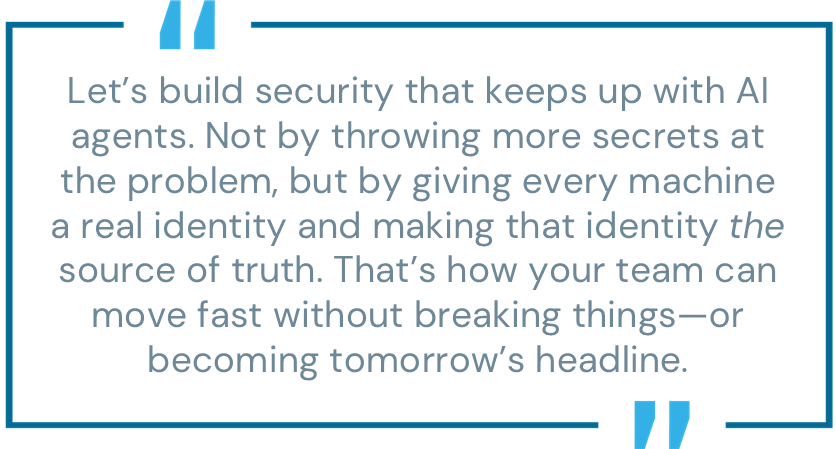
AI agents aren’t waiting in the wings anymore. They’re approving payments, spinning up cloud resources, and pulling sensitive data at machine speed. Blink, and a swarm of them has already acted a thousand times before anyone can check the logs. But with all that speed and capability comes risk.
For many teams, it’s the authentication model—not the tech—that’s breaking. Too many organizations still hand out static secrets like API keys, tokens, and long-lived certificates pretty much like it’s 1999. But that approach doesn’t scale when machines outnumber humans by more than 80 to 1, and workloads appear and disappear in milliseconds.
There are three actors that matter on today’s networks: people, AI agents, and machines. But AI agents and machines don’t sit still. They show up, do work, vanish, and their identity surface morphs every second. If you’re betting on static secrets to police it, you’re playing goalie blindfolded. But of course, AI agents are different than traditional machines like VMs and microservices: they’re non-deterministic and bring differing levels of action and reasoning.
Workload identity helps fix that broken authentication model for traditional, deterministic machines and now AI agents. Instead of relying on brittle, static secrets, a strategy built on open standards, like the CNCF-backed SPIFFE, provides every workload (VM, container, function, or AI agent) with a cryptographic identity that’s born, verified, and retired as fast as the workload itself. All without guesswork, shared badges, or GitHub ghosts.
Authentication crisis: Why static secrets fail to secure AI agents
Human identity and access management (IAM) was built for directories and predictable lifecycles. Machine identities weren’t, and increasingly, these identities live in the cloud. In clusters, meshes, and pipelines. With change, drift, and more developers, sprawl happens—fast. Secrets wind up baked into production repos, pasted in Slack convos, and even exposed in public code. “Temporary” becomes permanent, and renovation happens around them.
And because a secret is code, it lacks context. No one necessarily knows who owns it, when to use it, or whether it should even exist at all. If the inventory doesn’t have that requisite information, rotation can’t save the day; you could rotate thousands of tokens and still overlook one, which could trigger an outage or become an attacker’s foothold.
The 2024 U.S. Treasury attack is just one example, and it all stemmed from a single API key. On the availability side, cloud platforms suffer from misconfigurations and certificate-related outages.
But an AI agent going awry? That could cause a ripple effect across multiple services, systems, and repositories simultaneously.
How AI agents increase the need for strong workload identity
AI agents don’t wait for a human nudge. They learn, adapt, and act. They chain tools and services across environments in real time. They also multiply by orders of magnitude, with many agents performing tasks but with subtle differences in scope, data access, and behavior.
That creates three realities:
- Autonomy without brakes: An AI agent can make privileged changes before anyone asks if it should. Without a unique identity, you can’t tell “good” from “bad,” and you can’t pull the plug with precision. Identity must become the kill switch.
- Privilege amplification: Agents often need broad reach: data stores, workflow triggers, cloud resources. Carry over old robotic process automation (RPA) habits—like bots sharing human credentials for convenience—and you’ll recreate yesterday’s problems at today’s speed and scope. That’s why every agent needs a distinct identity, not a borrowed human one.
- Fast, ephemeral, everywhere: Agents are cattle, not pets, as my colleague Matt Barker says. They spawn, act, and disappear, just like cloud native workloads. Manual credential wrangling won’t keep up. Static secrets trail behind and get orphaned, and attackers love leftovers.
The pivot from secrets to workload identity: A new security paradigm for AI agents
Attackers don’t care about your org chart, but they do care about access, and if secrets aren’t managed, you’re rolling out the welcome mat—and the red carpet—in one go.
Because secrets can’t prove who’s really behind an API call.
Workload identity changes that. It shuts down casual access at the source by making “Who are you, right now?” the first and last question every system asks. And if you adopt workload identity security that’s built on a standard like SPIFFE, here’s what changes for your AI agents:
- Every agent is itself. When an AI agent comes online, it gets a short-lived, cryptographically verifiable identity tied to what it is and where it runs. No impersonation. No shared badges. Every action maps to a specific agent.
- Secrets stop being a single point of failure. Short-lived identities replace long-lived credentials. An attacker who finds a stale key can’t reuse it; your system slammed the window shut minutes ago.
- Zero Trust becomes real for AI agents and machines. Every request demands proof continuously. Policies follow identity and context, not IP ranges or outdated nostalgia practices.
- It fits how the cloud actually works. Auto-rotation, short lifetimes, and identity-aware authorization make sense where things spin up and down in seconds. If something is compromised, it ages out before an attacker gets comfortable.

And yes, this pattern runs at scale. Engineering orgs already use identity-aware meshes and SPIFFE-style issuance in production. You’d bring that same rigor to AI agents, especially in Kubernetes operating environments.
The cost of overlooking workload identity for AI agent security
Skipping the lessons learned from workload identity and securing AI agents can become frustratingly difficult. Without these protections in place, organizations risk facing challenges like:
- Cascading outages: A missed renewal or leaked access token can topple systems you didn’t realize were connected. Since machine identities underpin everything from edge gateways to internal APIs, one failure can result in many more dependent ones.
- Breaches you can’t attribute: Shared credentials and orphaned secrets erase accountability. Was it a misconfiguration or a hijacked AI agent? You’re left in the dark without a unique identity, guessing symptoms and causes.
- Board-level and regulatory pain: Auditors ask simple questions: who accessed what, when, and why? If the answer is, “We don’t know,” you could feel it in fines, renewals, and next year’s budget. Right when you need runway to modernize.
- Velocity drag: Engineering slows down to avoid breaking production. That’s the quiet cost. Speed gets traded for fragile safety.
Best practices for securing AI agents with workload identity
By applying lessons from workload identity to AI agents, you can help make these “intelligences” unique, identifiable, and verifiable. This is the foundation of strong identity security for modern, machine-driven environments. To achieve this new state of security, every agent should be treated as a workload, each given a SPIFFE SVID. This practice can help prevent shared tokens and static keys left in production pipelines. With rotation as the default, requests no longer get buried in tickets or email chains.
You can limit authorization using the principle of least privilege (PoLP), so AI agents aren’t given broad roles for the sake of convenience. They act only within their defined scope.
Agent-to-tool and agent-to-agent connections can leave a signed and auditable trail, so you can trace and revoke permissions whenever needed.
And finally, because every agent would be represented by its own identity, that identity itself becomes a kill switch, meaning you can better quarantine or terminate actions without damages flowing across your infrastructure.
Security shouldn’t slow AI agents down, but it should clear the way
By giving AI agents a unique and universal identity through an approved, standardized framework like SPIFFE, you can achieve the speed and safety required for the new agentic frontier. And you have the kill switch to stop any one agent.
Most importantly, this shift in perspective helps move the conversation from “Can we trust this AI agent?” to “Prove it.”—for every agent and every request, all at machine speed.
So, let’s build security that keeps up with AI agents. Not by throwing more secrets at the problem, but by giving every machine a real identity and making that identity the source of truth. That’s how your team can move fast without breaking things—or becoming tomorrow’s headline.
And that’s how we secure AI agents for what they really are: the newest, busiest “intelligence” in your enterprise.
Kevin Bocek is senior vice president of innovation at CyberArk.
Are your clusters a cluster? Join us in Atlanta for CyberArk’s Workload Identity Day Zero—happening the day before KubeCon. Meet thought leaders from across the cloud-native community—including Uber, Block, and Ford—and get practical insights on securing AI agents and workloads at scale.





















